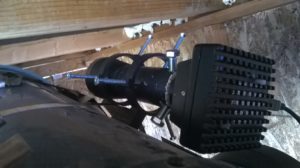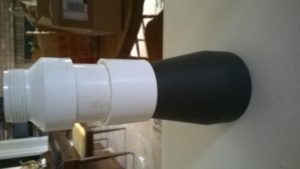Alas, my SBIG ST-2000 camera caught on fire! The video processor chip slagged, taking some of the main board with it. It may be fixable…or not! So the AAVSO (The American Association of Variable Star Observers) loaned me a SBIG ST-402 with BVIC photometric filters. However, this created an issue. No autoguiding chip. The ST-2000 had a dedicated auto-guider CCD chip that made high quality images possible. The ST-402 does not.
So time to get the junk box out! I took a hand held monocular made out of one half of a binocular, cut the tube, put in 3 set screws to hold a camera and added a Meade DSI Pro CCD I had laying around. On the one clear night we have had in weeks it worked fairly well as an autoguider. Unfortunately, the focal length of the 50 mm monocular is not enough to auto-guide without errors. So 60 second images were oval not round. There is a 10 to 1 rule for autoguiders. For every 10 mm of focal length on the main scope you need 1 mm of focal length for an autoguider scope. I was about 15 mm short!
So I took a 60 mm monocular I got off a broken pair of binoculars and made a auto-guiding scope out of it. It has enough focal length to make the auto guider more effective. It also has a means to do helical focusing. It is amazing what you can find from Lowes!
Making a auto-guiding scope created another issue. I have been using CCDSoft for about 4 years. Works great with CCDCommander, SBIG guide chip cameras and The Sky 6 Pro. Does not work with an external scope and camera! So I had to set up Maxim DL5 to autoguide. Works very good, but it was a bear to set up! It is a very flexible program but the manual will be your best friend!
Hopefully in the next few weeks the monsoon weather will break and clear skies will dominate. It has been great to see New Mexico so green but it plays havoc on astronomy pursuits!
Clear Skies!
Paul
50 mm Auto-guiding scope (Top)
60 mm auto-guidng scope (Bottom 2)


